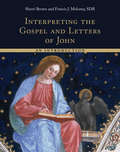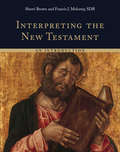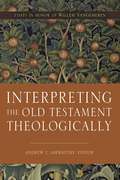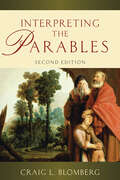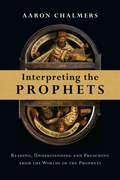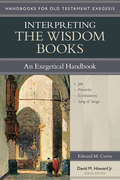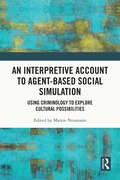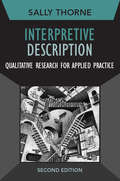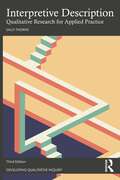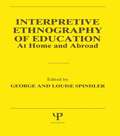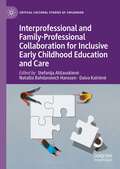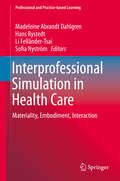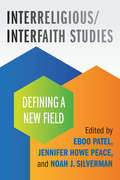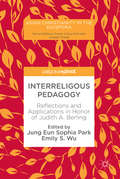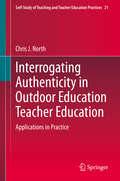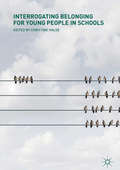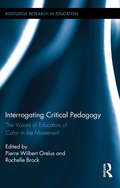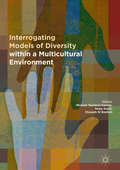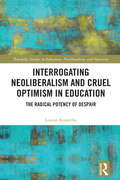- Table View
- List View
Interpreting the Gospel and Letters of John: An Introduction
by Sherri Brown Francis J. MoloneyAccessible, comprehensive, and up-to-date, Interpreting the Gospel and Letters of John is an ideal text for students new to the discipline of biblical studies. Sherri Brown and Francis J. Moloney present a broad overview of the story of Christianity arising out of its Jewish foundations and proceed to guide readers expertly through the contents of the Gospel and Letters of John. Maintaining that Johannine literature is best understood against the background of the Old Testament covenant metaphor, Brown and Moloney focus on the central role of covenant in the narrative of John's Gospel and highlight the Evangelist's use of fulfillment language. Helpful sidebars, maps, questions for review, and further-reading lists are placed throughout the text, making this volume well suited for classroom use.
Interpreting the Gospel and Letters of John: An Introduction
by Francis J. Moloney Sherri BrownAccessible, comprehensive, and up-to-date, Interpreting the Gospel and Letters of John is an ideal text for students new to the discipline of biblical studies. Sherri Brown and Francis J. Moloney present a broad overview of the story of Christianity arising out of its Jewish foundations and proceed to guide readers expertly through the contents of the Gospel and Letters of John. Maintaining that Johannine literature is best understood against the background of the Old Testament covenant metaphor, Brown and Moloney focus on the central role of covenant in the narrative of John's Gospel and highlight the Evangelist's use of fulfillment language. Helpful sidebars, maps, questions for review, and further-reading lists are placed throughout the text, making this volume well suited for classroom use.
Interpreting the New Testament: An Introduction
by Sherri Brown Francis J. MoloneyA succinct and accessible text for teaching students how to interpret the New TestamentThis new textbook effectively introduces students to the art and craft of biblical interpretation. New Testament scholars Sherri Brown and Francis Moloney begin by orienting students to the world of the Bible, exploring contemporary methods for interpreting the biblical literature, and showing how the Old Testament is foundational to the formation of the New Testament.The book proceeds to lead readers through the books of the New Testament by genre:* The Narratives: Gospels and Acts* Paul and His Letters* Hebrews and the Catholic Epistles* Apocalyptic Literature and the Book of Revelation Unlike book-by-book introductory textbooks that tend to overshadow the primary biblical text with lots of detailed information, Brown and Moloney&’s Interpreting the New Testament actually facilitates the study of the New Testament itself. Their concluding chapter reflects on the challenge of the New Testament to our present world.
Interpreting the New Testament
by Francis J. Moloney Sherri BrownA succinct and accessible text for teaching students how to interpret the New TestamentThis new textbook effectively introduces students to the art and craft of biblical interpretation. New Testament scholars Sherri Brown and Francis Moloney begin by orienting students to the world of the Bible, exploring contemporary methods for interpreting the biblical literature, and showing how the Old Testament is foundational to the formation of the New Testament.The book proceeds to lead readers through the books of the New Testament by genre:* The Narratives: Gospels and Acts* Paul and His Letters* Hebrews and the Catholic Epistles* Apocalyptic Literature and the Book of Revelation Unlike book-by-book introductory textbooks that tend to overshadow the primary biblical text with lots of detailed information, Brown and Moloney&’s Interpreting the New Testament actually facilitates the study of the New Testament itself. Their concluding chapter reflects on the challenge of the New Testament to our present world.
Interpreting the Old Testament Theologically: Essays in Honor of Willem A. VanGemeren
by Andrew T. AbernethyHow should Christians read the Old Testament today? Answers to this question gravitate between two poles. On the one hand, some pay little attention to the gap between the Old Testament and today, reading the Old Testament like a devotional allegory that points the Christian directly to Jesus. On the other hand, there are folks who prioritize an Old Testament passage’s original context to such an extent that it is by no means clear if and how a given Old Testament text might bear witness to Christ and address the church.This volume is a tribute to Willem A. VanGemeren, an ecclesial scholar who operated amidst the tension between understanding texts in their original context and their theological witness to Christ and the church. The contributors in this volume share a conviction that Christians must read the Old Testament with a theological concern for how it bears witness to Christ and nourishes the church, while not undermining the basic principles of exegesis.Two questions drive these essays as they address the topic of reading the Old Testament theologically.Christology. If the Old Testament bears witness to Christ, how do we move from an Old Testament text, theme, or book to Christ?Ecclesiology. If the Old Testament is meant to nourish the church, how do scriptures originally given to Israel address the church today?The volume unfolds by first considering exegetical habits that are essential for interpreting the Old Testament theologically. Then several essays wrestle with how topics from select Old Testament books can be read theologically. Finally, it concludes by addressing several communal matters that arise when reading the Old Testament theologically.
Interpreting the Prophetic Word: An Introduction to the Prophetic Literature of the Old Testament
by Willem A. VangemerenThe diversity of prophetic voices in the Bible provides a message that is rich and variegated. But the variety of the testimony can be lost by limiting one's interpretations or application of the prophetic word. Interpreting the Prophetic Word helps readers understand the harmony of the voices that reveal God's purposes in redemptive history. Dr. Willem VanGemeren explains clearly and fully the background of the prophetic tradition. He then interprets the message of the major and minor prophets, using historical context and literary form and structure as tools in his analysis. He concludes with an explanation of the relevance of the prophetic word today. Dr. VanGemeren's extensive research and scholarship is presented in a readable way to unlock the door of prophecy for readers. He helps them to interpret prophecy and invites them to listen to the prophets and to lives the prophetic word.
Interpreting the Prophets: Reading, Understanding and Preaching from the Worlds of the Prophets
by Aaron ChalmersThe prophetic books are some of the most captivating and fascinating texts of the Old Testament, but they are also some of the most misunderstood. Interpreting the Prophets equips the reader with the knowledge and skills they need to interpret the Prophets in a faithful and accurate fashion. Beginning with the nature of the prophetic role and prophetic books in Israel, Old Testament scholar Aaron Chalmers leads the reader through the various "worlds" of Israel's prophets—historical, social, theological and rhetorical— providing the basic contextual and background information needed both for sound and sensible exegesis, and for sensitive interpretation and application for today. He concludes with a helpful chapter giving guidelines for preaching from the Prophets—including advice on choosing the texts, making appropriate analogies, and the potential problems and common pitfalls to avoid.
Interpreting the Wisdom Books: An Exegetical Handbook (Handbooks for Old Testament Exegesis)
by Edward M. CurtisThe Wisdom Literature of the Bible (Job, Proverbs, Ecclesiastes, and Song of Songs) is filled with practical principles for everyday life. While some Christians are deterred by the pragmatic character of these matter-of-fact guidelines, they are as integral to God's purposes for His people as the explicitly theological material that dominates other parts of Scripture. The Wisdom books tie these two streams of God's revelation together in a way that enriches and strengthens the church.It is a thorough resource for pastors and teachers to help them navigate the sometimes bewildering waters of the Wisdom Literature.
An Interpretive Account to Agent-based Social Simulation: Using Criminology to Explore Cultural Possibilities
by Martin NeumannUsing the investigation of criminal culture as an example application, this edited volume presents a novel approach to agent-based simulation: interpretive agent-based social simulation as a methodological and transdisciplinary approach to examining the potential of qualitative data and methods for agent-based modelling (ABM). Featuring updated articles as well as original chapters which provide a cohesive and novel approach to the digital humanities, the book challenges the common conviction that hermeneutics and simulation are two mutually exclusive ways to understand and explain human behaviour and social change. Exploring how methodology benefits from taking cultural complexities into account and bringing these methods together in an innovative combination of qualitative-hermeneutic and digital techniques, the book unites experts in the field to connect ABM to narrative theories, thereby providing a novel tool for cultural studies. An innovative methodological contribution to narrative theory, this volume will be of primary benefit to researchers, scholars, and academics in the fields of ABM, hermeneutics, and criminology. The book will also appeal to those working in policing, security, and forensic consultation.
Interpretive Description: Qualitative Research for Applied Practice (Developing Qualitative Inquiry)
by Sally ThorneThe first edition of Interpretive Description established itself as the key resource for novice and intermediate level researchers in applied settings for conducting a qualitative research project with practical outcomes. In the second edition, leading qualitative researcher Sally Thorne retains the clear, straightforward guidance for researchers and students in health, social service, mental health, and related fields. This new edition includes additional material on knowledge synthesis and integration, evidence-based practice, and data analysis. In addition, this book takes the reader through the qualitative research process, from research design through fieldwork, analysis, interpretation, and application of the results; provides numerous examples from a variety of applied fields to show research in action; uses an accessible style and affordable price to be the ideal book for teaching qualitative research in clinical and applied disciplines.
Interpretive Description: Qualitative Research for Applied Practice (Developing Qualitative Inquiry)
by Sally ThorneInterpretive Description: Qualitative Research for Applied Practice has established itself as the key resource for novice and intermediate level researchers in applied settings for conducting a qualitative research project with practical outcomes.This book takes the reader through the qualitative research process, from research design through fieldwork, analysis, interpretation, and application of the results; provides numerous examples from a variety of applied fields to show research in action; and uses an accessible style to be the ideal book for teaching qualitative research in clinical and applied disciplines. In this new, third edition, leading qualitative researcher Sally Thorne retains the clear, straightforward guidance for researchers and students in health, social service, mental health, and related fields. This new edition includes additional material on positionality, disciplinary blindspots, design logic, arts-based approaches, diversity, mixed methods, writers' block, and dealing with critique. It has been comprehensively updated with new references and case examples throughout.Interpretive Description is an ideal resource for instructors and advanced students interested in qualitative research across a range of disciplines.
Interpretive Ethnography of Education at Home and Abroad
by George Louise SpindlerThis ambitious and unique volume sets a standard of excellence for research in educational ethnography. The interpretive studies brought together in this volume are outstanding discipline-based analyses of education both in the United States and in complex societies abroad.
An Interpretive Guide to Operatic Arias: A Handbook for Singers, Coaches, Teachers, and Students
by Martial SingherA premier singer and master teacher here tells other singers how to get the most from 151 famous arias selected for their popularity or their greatness from 66 operas, ranging in time and style from Christopher Gluck to Carlisle Floyd, from Mozart to Menotti. “The most memorable thrills in an opera singer's life,” according to the author's Introduction, “may easily derive from the great arias in his or her repertoire.”This book continues the work Martial Singher has done, in performances, in concerts, and in master classes and lessons, by drawing attention “not only to precise features of text, notes, and markings but also to psychological motivations and emotional impulses, to laughter and tears, to technical skills, to strokes of genius, and even here and there to variations from the original works that have proved to be fortunate.”For each aria, the author gives the dramatic and musical context, advice about interpretation, and the lyric—with the original language (if it is not English) and an idiomatic American English translation, in parallel columns. The major operatic traditions—French, German, Italian, Russian, and American—are represented, as are the major voice types—soprano, mezzo-soprano, tenor, baritone, bass-baritone, and bass.The dramatic context is not a mere summary of the plot but is a penetrating and often witty personality sketch of an operatic character in the midst of a situation. The musical context is presented with the dramatic situation in a cleverly integrated way. Suggestions about interpretation, often illustrated with musical notation and phonetic symbols, are interspersed among the author's explication of the music and the action. An overview of Martial Singher’s approach—based on fifty years of experience on stage in a hundred roles and in class at four leading conservatories—is presented in his Introduction. As the reader approaches each opera discussed in this book, he or she experiences the feeling of participation in a rehearsal on stage under an urbane though demanding coach and director.The Interpretive Guide will be of value to professional singers as a source of reference or renewed inspiration and a memory refresher, to coaches for checking and broadening personal impressions, to young singers and students for learning, to teachers who have enjoyed less than a half century of experience, and to opera broadcast listeners and telecast viewers who want to understand what goes into the sounds and sights that delight them.
An Interpretive Guide to Operatic Arias: A Handbook for Singers, Coaches, Teachers, and Students
by Martial SingherA premier singer and master teacher here tells other singers how to get the most from 151 famous arias selected for their popularity or their greatness from 66 operas, ranging in time and style from Christopher Gluck to Carlisle Floyd, from Mozart to Menotti. “The most memorable thrills in an opera singer's life,” according to the author's Introduction, “may easily derive from the great arias in his or her repertoire.”This book continues the work Martial Singher has done, in performances, in concerts, and in master classes and lessons, by drawing attention “not only to precise features of text, notes, and markings but also to psychological motivations and emotional impulses, to laughter and tears, to technical skills, to strokes of genius, and even here and there to variations from the original works that have proved to be fortunate.”For each aria, the author gives the dramatic and musical context, advice about interpretation, and the lyric—with the original language (if it is not English) and an idiomatic American English translation, in parallel columns. The major operatic traditions—French, German, Italian, Russian, and American—are represented, as are the major voice types—soprano, mezzo-soprano, tenor, baritone, bass-baritone, and bass.The dramatic context is not a mere summary of the plot but is a penetrating and often witty personality sketch of an operatic character in the midst of a situation. The musical context is presented with the dramatic situation in a cleverly integrated way. Suggestions about interpretation, often illustrated with musical notation and phonetic symbols, are interspersed among the author's explication of the music and the action. An overview of Martial Singher’s approach—based on fifty years of experience on stage in a hundred roles and in class at four leading conservatories—is presented in his Introduction. As the reader approaches each opera discussed in this book, he or she experiences the feeling of participation in a rehearsal on stage under an urbane though demanding coach and director.The Interpretive Guide will be of value to professional singers as a source of reference or renewed inspiration and a memory refresher, to coaches for checking and broadening personal impressions, to young singers and students for learning, to teachers who have enjoyed less than a half century of experience, and to opera broadcast listeners and telecast viewers who want to understand what goes into the sounds and sights that delight them.
Interprofessional and Family-Professional Collaboration for Inclusive Early Childhood Education and Care (Critical Cultural Studies of Childhood)
by Stefanija Ališauskienė Natallia Bahdanovich Hanssen Daiva KairienėThis edited volume covers issues related to educational research and practices for early childhood education and care (ECEC), highlighting interprofessional and family-professional collaboration within inclusive education in different cultural contexts. Contributors include authors from throughout Europe, including Lithuania, Norway, Iceland, Finland, Sweden, Spain, UK, and Ukraine. Chapters provide a forum for intentional dialogue about and shared understanding of successful and inspiring ECEC practices, the main barriers of interprofessional and family-professional collaboration, and opportunities for further improvement of inclusive ECEC practices.
Interprofessional Simulation in Health Care: Materiality, Embodiment, Interaction (Professional and Practice-based Learning #26)
by Madeleine Abrandt Dahlgren Hans Rystedt Li Felländer-Tsai Sofia NyströmThis book describes and discusses a practice-oriented approach to understanding and researching interprofessional simulation-based education and simulation. It provides empirical findings from research on this topic and is informed by practice-oriented perspectives. It identifies critical features of the simulation practice and discusses how these can be used in reforming simulation pedagogy. The book is divided into three sections. Section 1 sets the scene for understanding the practices of interprofessional simulation-based education and simulation. It provides a theoretical and methodological framework for the conceptualisation of practices and for the empirical studies on which the book is based. Section 2 revisits the dimensions of the simulation process/exercise, i.e. the briefing, simulation, and debriefing, and provides empirical analyses of how the practice of simulation unfolds. Based on these analyses, section 3 identifies and discusses how pedagogies for simulation can be reformed to meet the demands of future healthcare and research.
Interreligious/Interfaith Studies: Defining a New Field
by Noah Silverman Jennifer Howe Peace Eboo PatelA groundbreaking academic anthology that explores the emerging field of interreligious/interfaith studiesAs it is now backed by an impressive number of courses, academic programs and centers, faculty positions, journals and publications, funding, and professional partnerships, there is no longer a question as to whether the interreligious/interfaith field exists. But its meaning and import are still being debated. How is this field distinct from, yet similar to, other fields, such as religious or theological studies? What are its signature pedagogies and methodologies? What are its motivations and key questions? In other words, what is the shape of interfaith and interreligious studies, and what is its distinct contribution? These questions are the driving force behind this anthology.
Interreligous Pedagogy: Reflections and Applications in Honor of Judith A. Berling (Asian Christianity in the Diaspora)
by Jung Eun Park Emily S. WuThis volume is a collection of essays by former students of Judith Berling based on her revolutionary interreligious pedagogy. Her pedagogy can be summarized as a student centered, collaborative, and engaging teaching and learning process sparked by various ways of boundary-crossing. In this enterprise, each chapter explores the importance of understanding and negotiating “differences” through dialogue. The authors provide theoretical frameworks for engagements across conventional borders, and explore how the collaborative teaching model can be utilized in various teaching settings. As an example of her dialogical approach, Judith Berling herself provides a response to the chapters.
Interrogating Authenticity in Outdoor Education Teacher Education: Applications in Practice (Self-Study of Teaching and Teacher Education Practices #21)
by Chris J. NorthThis book addresses student passivity in teacher education. Using a developed metaphor, the author critically examines the use of authentic learning to design and implement learning experiences for preservice teachers, and reveals the opportunities and limitations of a focus on authenticity.This book prepares teachers for outdoor education using practice-based exemplars of applied teaching theories. Focusing on authentic pedagogies, it applies to all teacher educators who seek to engage in high-impact learning for their students, and is relevant for in-service educators, preservice teachers and researchers in the field of self-study.
Interrogating Belonging for Young People in Schools
by Christine HalseIn an era when many young people feel marginalized and excluded, this is the first comprehensive, critical account to shed new light on the trouble of ‘belonging’ and how young people in schools understand, enact and experience ‘belonging’ (and non-belonging). It traverses diverse dimensions of identity, including gender and sexuality; race, class, nation and citizenship; and place and space. Each section includes a provocative discussion by an eminent and international youth scholar of youth, and is essential reading for anyone involved with young people and schools. This book is a crucial resource and reference for sociology of education courses at all levels as well as courses in student inclusion, equity and student well-being.
Interrogating Critical Pedagogy: The Voices of Educators of Color in the Movement (Routledge Research in Education)
by Pierre Wilbert Orelus Rochelle BrockEducators, teacher practitioners, and social activists have successfully used critical pedagogy as a tool to help marginalized students develop awareness and seek alternative solutions to their poor educational and socioeconomic situations. However, this theory is often criticized as being mostly dominated by privileged white males, bringing issues of race and gender to the forefront. This volume provides insight on how critical pedagogy can be helpful to scholars and teachers alike in their analysis of racial, gender, linguistic and political problems. It features a wide range of respected scholars who examine the way and the degree to which critical pedagogy can be used to improve education for students of color, women and other marginalized groups.
Interrogating Models of Diversity within a Multicultural Environment
by Michael Tonderai Kariwo Neda Asadi Chouaib El BouhaliDiscussing common understanding of the concepts of multiculturalism, diversity, and inclusion, this volume critically examines the interpretation and praxis of diversity and inclusion in relation to marginalized populations—from women, sexual minorities, minority newcomers, and aboriginal communities. The contributors collected here present well-grounded epistemological, theoretical, and methodological bases from which to account (at least in part) for the processes and dynamics shaping the relationship between diversity and inclusion, on the one hand, and policy and practice on the other. Arising from research derived in part from community work with minorities in North America, particularly Canada, this volume examines common barriers to full minority integration, with important implications for inclusion efforts around the globe.
Interrogating Nation-Statehood and the Citizen in Curriculum Development: Comparative Historical Cases (Studies in Curriculum Theory Series)
by Nicole GotlingThis book dives into the histories of nation-state-building and curriculum formation to explore the ways that they intertwine, form and inform each other.This book follows the understanding that nation-states have – and still do – develop their educational institutions, curricula, and teaching materials with specific goals and with a specific idea of the ideal student and citizen they want to create in mind. In particular, it advocates that analyzing multiple, idiosyncratic cases can inform the connection between what we learn, how we learn it, and who we become as citizens and further, that this is related not to linear or global phenomena, but to particular nation-states, curricula, and time periods. This book focuses on the comparison between four cases during the time of the large, map-changing events and period of the Prussian Wars (1864–1871) to make the intertwined relationships between nation-states and their curricula, designed to create future loyal citizens, more apparent. It makes a point of reconstructing each of the nation-states' historical national-political and educational processes, and then the reconstructed trajectories are compared both in their own trajectories over time throughout the 19th century and up until World War II and in relation to other nation-states' trajectories over the same long timespan.Exploring a new pathway into research on the intersection of education, curriculum, and nationalism and providing a new, extensively researched and formed methodological framework, it will appeal to researchers, academics, and postgraduates with interests in comparative and international education, curriculum studies, the history of education, nationalism, state-building, and textbook analysis.
Interrogating Neoliberalism and Cruel Optimism in Education: The Radical Potency of Despair (Routledge Studies in Education, Neoliberalism, and Marxism)
by null Louise AzzarelloThis book is a philosophical examination of the ways in which neoliberalism underpins and impedes public education. It proposes that education’s adoption of neoliberal logic generates a sense of despair amongst educators, who often enter the profession with the hope of building a better, more just world.Drawing on the author’s 27 years of experience as a secondary classroom teacher and engaging with a range of theoretical concepts, cultural objects, and scenes of violence from her time in the classroom, The Radical Potency of Despair renders visible the ongoing harms that neoliberal logic creates for education and educators. The author proposes a new “ruptured fantasy of education” and suggests that it is not hope that ignites educators who keep fighting for education, but rather despair. Despair is conceived of as a generative force, provoking educators to hold time and space open for pedagogical encounters that interrupt the ongoing instrumentalization of education. The author further conceptualizes a notion of thinking with images as a pedagogical interruptive force. Thinking with images, she argues, gives students time and space to attend to what they see, thus affording them the chance to think differently about the violence of modern society. Such pedagogical interruptions are presented as a refusal of the normative order of education, countering present infrastructures that aim to constrain and instrumentalize education.A compelling and original volume, it will appeal to scholars, researchers, and upper-level students with interests in neoliberalism and education, the philosophy of education, critical pedagogy, and educational policy and politics.
